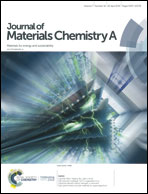Delicate lattice modulation enables superior Na storage performance of Na3V2(PO4)3 as both an anode and cathode material for sodium-ion batteries: understanding the role of calcium substitution for vanadium†
Abstract
Na3V2(PO4)3 with a 3D open NASICON framework can accommodate a wide range of Na contents, which makes it capable of working as both a cathode and anode material. However, severe capacity degradation and inferior rate capability resulting from low electronic/ionic conductivities and poor structural stability have hindered its practical implementation. Herein, excellent sodium storage performance of Na3V2(PO4)3 is realized by delicate lattice modulation. Aliovalent Ca2+ substitution for V3+ increases both the electronic and ionic conductivities by producing electronic defects and enlarging the sodium ion migration channels. DFT calculations reveal that the fifth Na ion intercalation/deintercalation produces a large lattice volume change, which is possibly the origin of the poor redox reaction reversibility of Na3V2(PO4)3 at low potential (∼0.3 V vs. Na+/Na). The Ca2+ doping enhances significantly the structural stability to suppress the large crystal lattice distortion during the anode reaction process. The multiple effects enable superior rate-capability and ultralong cycle-life of Ca-doped Na3V2(PO4)3 as both a cathode and anode material. The symmetric full cell constructed with the optimized Na3V1.95Ca0.05(PO4)3@C electrode delivers a very high energy density of 166 W h kg−1 and an exceptional cycling stability (0.02% capacity decay per cycle over 2000 cycles at 10C rate). This study provides a feasible strategy for obtaining high-rate and long cycle-life electrode materials for high-efficiency energy storage.



 Please wait while we load your content...
Please wait while we load your content...